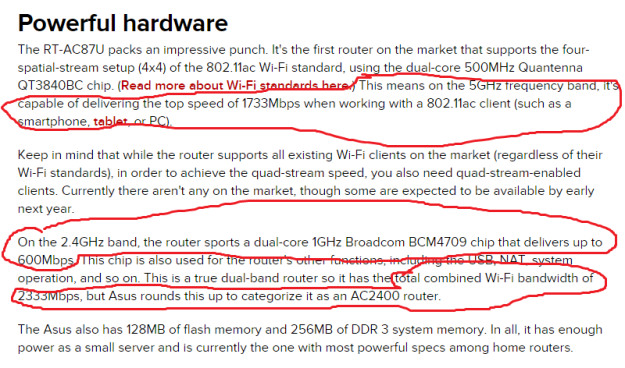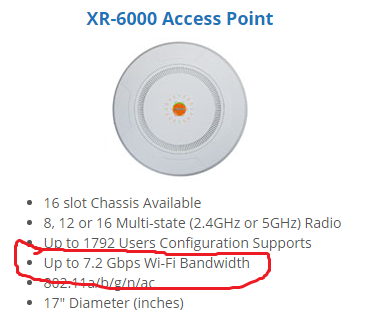It ought to be sooooo easy to achieve great Wi-Fi these days. All the makings are there, right? We got the promise of “Gigabit Wireless” and an endless pipeline of screamin’, smokin’ WLAN hardware. Just take a looksee:
Man, that all sounds really nice. Then there’s this:
Wowsers, that’s fast. And there are plenty of other fast wireless access points out there from every vendor under the sun, and at every price point. The good times are a’ rolling. All you have to do is spend some money, hang up one of these rocket ships, and bask in the glow of Gigabit Wireless connecting your iPad to Netflix at breakneck speeds. Woo woo!
Yeah, right. If only it were that simple.
The truth is, you may NEVER have this kind of great Wi-Fi. Get used to it. The lofty numbers you see on anyone’s glossy are pretty much out of your reach, and there is not thing one that you can do about it, Bucko. Now let’s talk about why.
If great Wi-Fi is defined by the promise of gigantic, outsized throughput numbers, it’s pretty much screwed before product ships. Why? Because most products that do ship tend to end up in The Real World, which happens to be a pretty cruel place for Wi-Fi signals. Even common sense factors that ought to add up to great Wi-Fi frequently don’t… including:
- Strong Signal
- Lots of APs
- 802.11ac
- Expensive gear with huge specs
- Professional surveys and installations
It turns out that strong signals can be deceiving (take the ‘a’ and ‘r’ out of bars and you get closer to the truth on signal strength widgets…). You might have a bucket full of signal showing in your client indicator, but a lot of it could be performance-sucking noise or interference in the mix. Or it could truly be great signal, bolted up to a crappy LAN or tiny Internet pipe (say hello to Mr. Bottleneck) which makes the Wi-Fi feel slow.
Lots of APs carefully laid out and functionally coordinated in a High Density environment can be a good thing. Lots of APs without coordination, like from neighboring WLANs can be a disaster. Here we have interference of various sorts, and even rogue devices and Man-in-the-Middle attackers when the environment is AP-fat but untended.
Just because an investment is made in 802.11ac, that doesn’t guarantee you’ll get anywhere near the vendor’s performance promises. A laundry list of parameters has to click before those big numbers are possible (client type and config, spectral cleanliness, no other clients competing for AP, proximity to AP, uplink quality, LAN quality, all can be contributing factors) and chances are you’ll rarely ever come close to what the hype promises.
I’m a firm believer in the adage “you usually get what you pay for” and expensive gear typically fetches a premium because it’s better made with beefier resources (CPU, memory, radio technology, physical construct, feature sets) than the cheaper competition. But even the best gear can’t overcome the laws of physics when the RF space is hostile, and can’t make the WLAN perform any better if your core services like DHCP, NAT, DNS, and routing are flaky. Then there’s that pesky ISP connection thing again… your “Gigabit Wi-Fi” (which happens to still be half-duplex so a Gig ain’t a Gig to begin with) might be peppy on the local network, but it becomes a 10 Mbps connection if you’re heading off to the Internet on an ISP connection of that size.
Then there’s the critical professional survey and WLAN design. There are absolute advantages to having a professional originate the WLAN design for a business network. But I can design you the prettiest WLAN in the land yet have it’s performance undermined by bad operational policy, an over-zealous NAC system, crappy code, or some new consumer-grade cheesewhiz client that you insist on providing access to.
By now, you get the point- there are a lot of detractors from “great” Wi-Fi. But it does get even worse… with every new kick-ass, performance-promising Wi-Fi standard, we also have a culture of backwards compatibility and unstructured feature sets. Wireless gadgets from 2001 MUST be accommodated on even the latest gear, and BYOD and IoT bring a flood of odd-ball, often ill-conceived consumer-grade gadgetry to the business WLAN that knock the life out of potentially great Wi-Fi. This trend is only getting worse, with no end in sight.
Enough of the Gloom! All is not lost.
Are you sufficiently bummed out yet? Truth be told, little that I’m whining about here is new under the Wi-Fi sun. It’s just that wireless is getting ever more pervasive, and so the deficiencies in the WLAN paradigm that have always been there are magnified- especially as we see promised top-end speeds that approach fairy-tale quality. I offer that great Wi-Fi has little to do with achieving those lofty throughputs, and is actually about a solid experience that works well for end users and results in very, very few trouble tickets.
To get to THIS definition of great Wi-Fi, where things just work so well that users could give a fig what their actual data rates are, you have to look at any environment holistically. Solid WLAN needs excellent design, but also excellent LAN and core services, and a decent pipe to the Internet. Good policy, systematic onboarding, and client education are the icing on the cake. However an individual environment shakes out, great Wi-Fi is as much a well managed state of being as it is an exercise in big numbers.
Please note: Andrew von Nagey is running a very quick survey on WLAN Vendor Selection Criteria through the end of July. Please consider contributing, and sharing what is important to you when WLAN shopping. Thanks!


